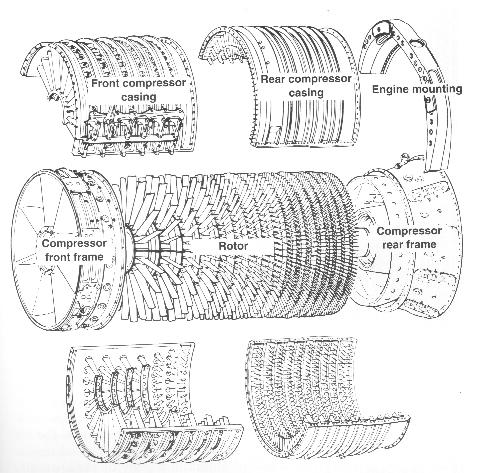The Compressor
There are two main styles for turbine compressors:
the axial and the centrifugal.
The Axial Compressor
Exploded view of an axial compressor

Image taken from Jet Engines
-
The axial type compressor is made up of many small blades,
called rotor vanes, arranged in rows on a cylinder whose radius gets larger
towards the back (as can be seen from the above picture). These blades
act much like small propellors.
-
In between these rotor vanes are stator vanes which stay
in a fixed spot and straighten the air coming out of the previous stage
of rotor vanes before it enters the next stage.
-
On some newer engines, the angle of these stator vanes can
be adjusted for optimum efficiency.
-
Each stage (1 row of rotor and stator vanes) generally provides
for a pressure rise of about 1.3:1 (so after the first stage, the pressure
would be 1.3 above atmospheric, after the second it would be 1.69, 2.2,
etc...).
The Centrifugal Compressor

Image taken from Aircraft Gas Turbine Engine Technology
-
Air enters the centrifugal compressor at the front and center.
The blades then sling the air radially outwards where it is once again
collected (at a higher pressure) before it enters the diffuser.
-
Pressure rise per stage is usually about 4 to 8:1 (higher
than axial). These can be sombined in series (that is the exit of
the first leads to the entrance of the next) to produce a greater pressure
rise. But more than two stages is not practical.
Misc. Compressor Stuff
-
The axial and centrifugal compressor described above can
be combined together with the axial compressor in front.
-
The horsepower required to drive a compressor is very large.
The formula for figuring this out is:
HP = Cp
x (T2-T1) x Wa x 1.414
Where Cp is the specific heat of air, (T2-T1) is the
change in temperature across the compressor, and Wa is the airflow through
the compressor in pounds /sec.
A typical example is the JT-9 used on 747's.
HP = .24 x 670(deg F) x 247(lbs/sec) x 1.414
HP = 56160 horsepower, assuming 100 percent efficiency
-
The compressor can be tapped near the end to provide pressurized
heated air to other systems of the airplane. Most planes use this
"bleed air" for pressurizing and heating the cabin.
Also, many pump it through the leading edge of the wings to melt ice during
icing conditions. This reduces the efficiency of the compressor some,
but is usually not much of a factor.
-
An engine running at take off power can consume more than
2000 pounds of air per second. That's about 27000 cubic feet of air/second
(at atmospheric pressure and 70 deg F). PV = mRT => V = mRT
/ P = (2000lbm x 0.3704(psia x ft3/lbm x R) x (70 + 460)deg R ) / (14.7
psia) = 26709 ft3.


